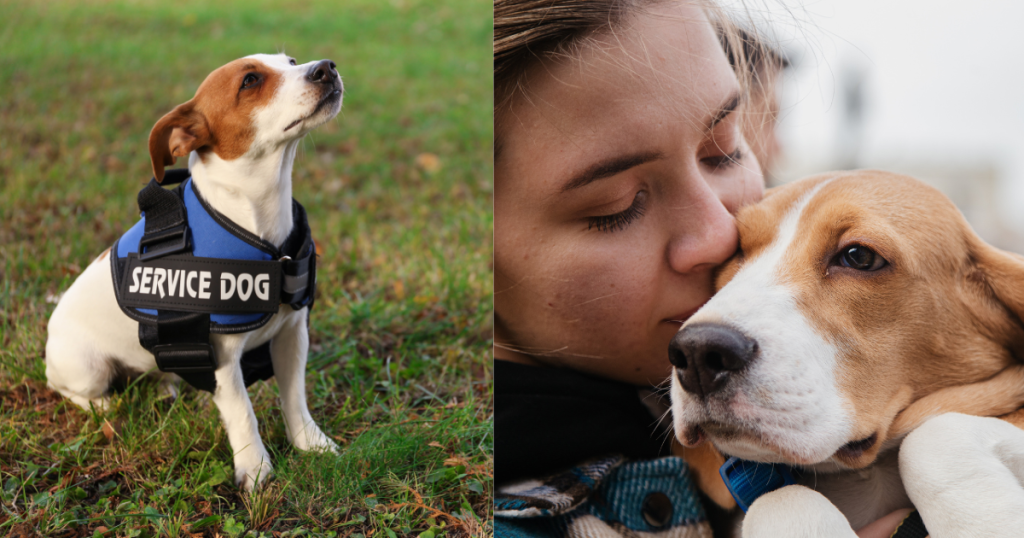Choosing between an Emotional Support Animal (ESA) and a Service Dog is one of the most misunderstood decisions in the world of animal companionship and disability support. At first glance, the difference may seem simple, one provides comfort, the other performs tasks. But as we’ve learned through years of advocacy and personal experience with Emma and Buddy, the truth goes much deeper. Understanding these distinctions isn’t just about following rules; it’s about protecting your rights, your animal’s well-being, and the integrity of what assistance animals truly represent.
Key Takeaways
- Service dogs are legally recognized under the ADA and trained to perform tasks that directly assist a person with a disability.
- Emotional Support Animals (ESAs) offer therapeutic comfort through companionship but do not require specialized task training.
- Public access rights apply only to service dogs, while ESAs are mainly protected in housing situations under the Fair Housing Act.
- Documentation requirements differ, service dogs rely on demonstrated tasks, while ESAs need a letter from a licensed mental health professional.
- Choosing between an ESA and a service dog depends on whether your needs involve emotional comfort or specific assistance tasks.
Core Definitions & Types of Assistance Animals

Understanding Service Dogs and Assistance Dogs
Service dogs are legally defined under the Americans with Disabilities Act (ADA) as animals individually trained to perform tasks directly related to a person’s disability. These are not pets, they are working partners. Their training is rigorous, often requiring months or even years of conditioning to ensure reliability in public environments.
Only dogs, and in rare cases miniature horses, qualify under the ADA. Each service dog’s purpose is highly specialized: a guide dog assists the visually impaired, a hearing dog alerts its handler to sounds, a medical alert dog detects physiological changes such as low blood sugar, and a psychiatric service dog helps mitigate anxiety or PTSD through specific, trained responses.
Understanding Emotional Support Animals (ESAs)
ESAs, on the other hand, offer therapeutic comfort simply by being present. They are not required to perform specific tasks, but their role in emotional regulation and mental wellness can be life-changing. They help individuals with conditions like depression, anxiety, or PTSD feel grounded and less isolated.
Unlike service dogs, ESAs can be a variety of species; dogs, cats, rabbits, or even birds. While ESAs require no formal training, they must still exhibit good behavior, especially in shared housing or public transport situations.
Other Related Terms
We often hear people confuse therapy animals, companion animals, and ESAs. Therapy animals provide comfort to others in institutional settings like hospitals or schools, while companion animals are household pets without legal protections. Psychiatric service dogs bridge a unique gap, performing trained tasks that distinguish them from ESAs, such as interrupting panic attacks or reminding their handler to take medication.
Key Functional Differences: Tasks, Behavior, and Training
| Feature | Service Dog | Emotional Support Animal (ESA) |
| Primary Function | Performs specific tasks to mitigate a disability | Provides comfort and emotional support through presence |
| Legal Definition | Protected under ADA, FHA, and ACAA | Protected mainly under FHA (housing) |
| Training Requirements | Must be individually trained to perform tasks | No specialized training required |
| Public Access Rights | Full access to public places and transportation | Limited access; mainly housing rights |
| Species Allowed | Dogs (and in rare cases, miniature horses) | Various species (dogs, cats, rabbits, etc.) |
| Handler Responsibility | Maintain control and behavior in all settings | Maintain good behavior; no public access guarantee |
| Documentation | No certification required; tasks define legitimacy | Letter from licensed mental health professional required |
| Travel Rights | Permitted on airlines with DOT forms | May travel as pets; fees and restrictions apply |
Training Requirements & Standards
Service dog training is highly structured. Every command, every cue, and every task must be performed reliably in a variety of environments. Some handlers train their own service dogs, while others work with professional trainers or organizations. In either case, the process involves behavioral conditioning, socialization, and public access testing.
ESAs, however, do not require such training. Their effectiveness lies in companionship and emotional support rather than learned tasks. Still, we encourage ESA owners to pursue at least basic obedience training to ensure their animal behaves appropriately in social or housing situations. A well-behaved animal builds trust and helps preserve the credibility of emotional support designations.
Behavior, Reliability & Public Readiness
A service dog must remain calm, focused, and non-reactive even in chaotic environments. Reliability defines its role; it cannot bark, lunge, or lose control under pressure. ESA behavior expectations are more lenient, but still, good manners go a long way in ensuring comfort for both owner and community.
When animals misbehave in public, it risks eroding the trust that legitimate service and ESA users have worked so hard to build. Responsible ownership is the foundation of credibility.
Use Cases & Typical Scenarios
A service dog might guide its handler across a busy intersection, alert them before a seizure, or apply pressure during a panic episode. An ESA’s presence can reduce feelings of loneliness, lower blood pressure, and provide a sense of security at home. Some individuals may benefit from both, for instance, someone with a mobility disability and coexisting anxiety.
Understanding your needs helps determine which category truly fits your situation. The distinction matters, both legally and ethically.
Legal Rights & Protections: ESA vs Service Dog
| Legal Aspect | Service Dog | Emotional Support Animal (ESA) |
| Governing Laws | Americans with Disabilities Act (ADA), Fair Housing Act (FHA), Air Carrier Access Act (ACAA) | Fair Housing Act (FHA) only |
| Public Access Rights | Allowed in most public areas (restaurants, hospitals, schools, etc.) | No general public access rights |
| Housing Protections | Full protection under FHA; reasonable accommodation required | Protected under FHA with documentation from licensed healthcare provider |
| Travel Rights | Permitted on flights with DOT forms confirming training and behavior | Considered pets; airlines may charge fees and limit access |
| Documentation Requirements | No federal certification required; performance of tasks defines legitimacy | Letter from licensed mental health professional required for housing accommodations |
| Species Allowed | Dogs and miniature horses (rare cases) | Various species (dogs, cats, birds, etc.) |
| State Variations | Some states expand rights and enforce penalties for misrepresentation | State protections vary; fewer public access provisions |
Federal Law Protections in the U.S.
Americans with Disabilities Act (ADA)
Under the ADA, service dogs have extensive public access rights. They can accompany their handlers into restaurants, hospitals, schools, and hotels. Businesses can only ask two questions: whether the dog is required because of a disability and what tasks it has been trained to perform. They cannot demand documentation or inquire about the disability itself.
The ADA’s scope ensures independence for individuals with disabilities, provided the service dog behaves appropriately and remains under control. However, this law does not extend to ESAs in public places.
Fair Housing Act (FHA) & Section 504
The FHA protects both ESA and service dog owners in housing situations. Landlords must make reasonable accommodations, even in properties with no-pet policies, as long as the animal’s presence alleviates a documented disability. That said, owners may be required to provide verification from a licensed healthcare professional linking their condition to the need for the animal.
Air Carrier Access Act (ACAA)
Until 2021, ESAs were allowed to fly with their owners without extra fees. However, new Department of Transportation (DOT) regulations now limit in-flight rights to service dogs only. ESAs may still travel as pets, but airlines are no longer required to grant special access. Service dogs remain protected, though handlers must complete DOT forms confirming their dog’s training and behavior.
State & Local Law Variations
Some states provide additional rights for ESAs, while others impose stricter verification processes. Understanding local laws is crucial before asserting access or housing accommodations. A few states, such as California and Florida, have also implemented penalties for falsifying service animal status.
Consequences for Misrepresentation & Fraud
Faking a service animal undermines trust and damages the credibility of legitimate handlers. Several states have introduced fines or even misdemeanor charges for misrepresentation. Beyond legal consequences, it creates public hostility toward those who genuinely rely on these animals.
Practical Considerations for Handlers & Stakeholders

Qualifying for a Service Dog or ESA
Obtaining either status begins with a legitimate diagnosis. For a service dog, the disability must substantially limit one or more major life activities, and the animal’s tasks must directly mitigate those limitations. For an ESA, a licensed mental health professional must determine that the animal’s presence offers therapeutic benefit.
Matching temperament and breed is another crucial step. Not every dog thrives in a service role, and not every cat is suited for emotional support. The bond must be natural and sustainable.
Registration, Certification & Identification
There is no official federal registry for either service dogs or ESAs. Beware of websites that sell certificates or vests claiming to make your animal “official.” These documents carry no legal authority. Identification gear may be helpful for social understanding, but it is optional. Transparency and honesty are always better than flashy credentials.
Tips for Public Use & Access
Handlers should maintain calm confidence when entering public places. Businesses should educate their staff to recognize and respect legitimate assistance animals. In case of disputes, remain polite, present knowledge of the law, and, if necessary, file a formal complaint through proper channels.
Landlord & Housing Relations
Requesting accommodations requires clarity and documentation. A letter from a licensed mental health professional can help explain how the animal supports the handler’s well-being. Open communication with landlords usually prevents conflict. Remember, landlords cannot charge pet deposits for verified ESAs or service dogs, but you remain responsible for damages.
Travel & Transportation Tips
Airlines now require pre-submitted forms for service dogs, and many rideshare companies allow them under ADA compliance. ESAs, however, may be treated as pets, subject to carrier fees and restrictions. Always check policies in advance to avoid last-minute issues.
Responsibilities, Care & Liability
No matter the classification, the handler bears full responsibility for their animal’s behavior and welfare. Regular grooming, veterinary care, and training refreshers ensure your animal stays ready and healthy. Liability insurance is a wise investment, especially for handlers in public-facing roles.
Addressing Common Myths & Misconceptions
- “Any dog can be a service dog if given a vest.” False. Only animals trained to perform specific tasks qualify.
- “A doctor’s note instantly makes my pet a service animal.” Incorrect. Documentation does not replace training.
- “ESAs have the same rights as service dogs.” They do not. ESA protections are limited to housing and, in some cases, workplace accommodations.
- “Certification is legally required.” There is no federal certification program for either category.
- “I can bring my ESA anywhere I want.” ESA access stops at public spaces that are not covered under housing or workplace laws.
The more we educate ourselves and others, the more respect and understanding we foster across communities.
Choosing the Right Path Forward
Determining whether you need a service dog or an ESA depends on the kind of support your condition requires. If your animal must perform specific tasks, then a service dog is the right choice. If emotional comfort and presence are the key benefits, an ESA might be sufficient.
Both paths demand compassion, honesty, and commitment. The journey to obtain either one is deeply personal, not just a legal matter but a partnership built on trust.At Emma and Buddy, we believe in empowering people to make informed decisions about their animal companions. Our goal is to help every individual understand their rights, respect the laws, and cultivate the beautiful relationship that exists between humans and animals.













